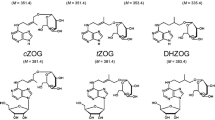Abstract
IT is the purpose of the present communication to describe some further results with carbon-14 precursors of ethylene, and to reconcile the pattern which emerges in these investigations using McIntosh apple tissue sections with that of the fungal system, Penicillium digitatum. The procedures have been described previously1–3, and their reliability for measuring 14C-ethylene and carbon dioxide commented on3; they were altered only in the use of a Cary–Tolbert ionization chamber in place of a Bernstein–Ballentine tube for measuring radiation. In the course of these experiments it was noted that alcohol vapour interferes with the assay for ethylene by dissolving in mercuric perchlorate absorbent where a slow acid-catalysed dehydration occurs. For example, when 10 µl. liquid ethanol was added to 20 ml. of mercuric perchlorate reagent, ethylene appeared at a linear rate for at least 6 h, by which time 0.02 per cent of the alcohol had been converted to olefine. Previously, Young et al.9 reported that ethanol was not measured by the mercuric perchlorate manometric procedure, but they apparently took no account of the duration of contact between alcohol and perchlorate, and it should be noted that gas chromatography detects much smaller quantities of vapour than does manometry. In the work recorded here it was determined that a discernible error could occur only if at the end of a collection period in excess of 1 µc. of 14C-ethanol had been formed in the tissue. In experiments with fumarate and acetate this would require that labelled ethanol form at approximately the same rate as 14CO2, and with other compounds ethanol production would greatly have to exceed 14CO2 evolution. Clearly, under the conditions of the assay, the results are not influenced by this factor except when 14C-ethanol itself was administered to the tissue (Table 1), in which case the apparent transfer of label to ethylene must be dismissed as an artefact.
This is a preview of subscription content, access via your institution
Access options
Subscribe to this journal
Receive 51 print issues and online access
$199.00 per year
only $3.90 per issue
Buy this article
- Purchase on Springer Link
- Instant access to full article PDF
Prices may be subject to local taxes which are calculated during checkout
Similar content being viewed by others
References
Burg, S. P., Arch. Biochem. Biophys., 84, 544 (1959).
Burg, S. P., and Burg, E. A., Plant Physiol., 37, 179 (1962).
Burg, S. P., and Thimann, K. V., Arch. Biochem. Biophys., 95, 450 (1961).
Gibson, M. S., and Crane, F. L., Proc. Plant Physiol., 37, 18 (1962).
Katz, J., and Wood, H. G., J. Biol. Chem., 235, 2165 (1960).
Noble, E. P., Reed, D. R., and Wang, C. H., Canad. J. Microbiol., 4, 469 (1958).
Reed, D. J., and Wang, C. H., Canad. J. Microbiol., 5, 59 (1959).
Wang, C. H., Persyn, A., and Krackov, J., Nature, 195, 1306 (1962).
Young, R. E., Pratt, H. K., and Biale, J. B., Anal. Chem., 24, 551 (1952).
Author information
Authors and Affiliations
Rights and permissions
About this article
Cite this article
BURG, S., BURG, E. Biosynthesis of Ethylene. Nature 203, 869–870 (1964). https://doi.org/10.1038/203869a0
Issue Date:
DOI: https://doi.org/10.1038/203869a0
This article is cited by
-
Microarray analysis of gene expression profiles in ripening pineapple fruits
BMC Plant Biology (2012)
-
Some characteristics of ethylene production in peach (Prunus persica L.) seeds
Planta (1976)
-
Interaction of ethylene, oxygen and carbon dioxide in the control of fruit ripening
Qualitas Plantarum et Materiae Vegetabiles (1969)
-
Acetate and Other Carboxylic Acids as Precursors of Ethylene
Nature (1966)
-
Genesis of Ethylene in Apples
Nature (1965)
Comments
By submitting a comment you agree to abide by our Terms and Community Guidelines. If you find something abusive or that does not comply with our terms or guidelines please flag it as inappropriate.



